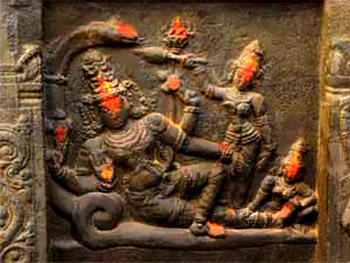 Venkataramana temple, also known as Chintala Venkataraman temple, was built during the Vijayanagara period in the mid-16th century. Located in Tadpatri in Anantpur district, Andhra Pradesh, it is dedicated to Lord Vishnu. Venkataramana temple is the temple of the incarnations of Lord Vishnu. There is a temple chariot at the entrance of the temple in stone that is shown being pulled by two horses. The Kalyan-mandap is in the southwestern corner. The main shrine has a maha-mandap, mukh-mandap, antaral and a garbhagriha. The main shrine is preceded by a closed mandapa with two porches. The outer walls are decorated with sculptures. The pyramidal tower consists of many storeys with plaster sculptures that is crowned by an hemispherical roof
Venkataramana temple, also known as Chintala Venkataraman temple, was built during the Vijayanagara period in the mid-16th century. Located in Tadpatri in Anantpur district, Andhra Pradesh, it is dedicated to Lord Vishnu. Venkataramana temple is the temple of the incarnations of Lord Vishnu. There is a temple chariot at the entrance of the temple in stone that is shown being pulled by two horses. The Kalyan-mandap is in the southwestern corner. The main shrine has a maha-mandap, mukh-mandap, antaral and a garbhagriha. The main shrine is preceded by a closed mandapa with two porches. The outer walls are decorated with sculptures. The pyramidal tower consists of many storeys with plaster sculptures that is crowned by an hemispherical roof
Sculpture of Venkataramana Temple
On a pillar of the large hall there is the sculpture of Lord Vishnu as Hrishikesh and as Hari. The image as Matsya avatar on a pillar is exceptional as in the lower right hand he holds the Vedas and with the other hand he tear opens the stomach of the demon Hayagriva.
In the image of Lord Vishnu as Kurma avatar, Vishnu is shown as half man with four hands and half tortoise. The next incarnation is Vishnu as Varaha saving the Earth from the underworld. Thereafter he is shown as Yoga-Narsimha in yoga posture. He is shown as putting one hand on the head of Prahlada. Rama Avatar has also been portrayed. Here Vishnu`s wife is shown with two legs across the left thigh of Lord Rama. Finally incarnation of Vishnu as Lord Krishna is seen who s shown lifting Mount Govardhan in order to protect Braj from the torrential rains of Lord Indra. The Kalki avatar is represented with the head of a horse and the body of a man; he has four hands and is himself seated on a horse.
There is an image of Lord Brahma who has a beard on each of his four faces and holds a ritual spoon and a net in his hands. On the northern wall of the Sanctum is the image of Mahishasuramardini Durga and Lord Vishnu as Vamana and as Krishna at the entrance of the palace of Kansa. On the western wall there is the image of Vishnu as Narsimha, with Devi, and as Krishna dragging a huge rock. On the southern wall also two epsodes from Krishna`s life have been depicted. In one his mother Yashoda trying to tie him down to a piece of rock is portrayed and in the other the ferocious Putan breast-feeding babies with poison is depicted. Krishna had sucked all the poison from her breasts till she died. In the Sanctum is the image of Vishnu as Venkateshvar.





















